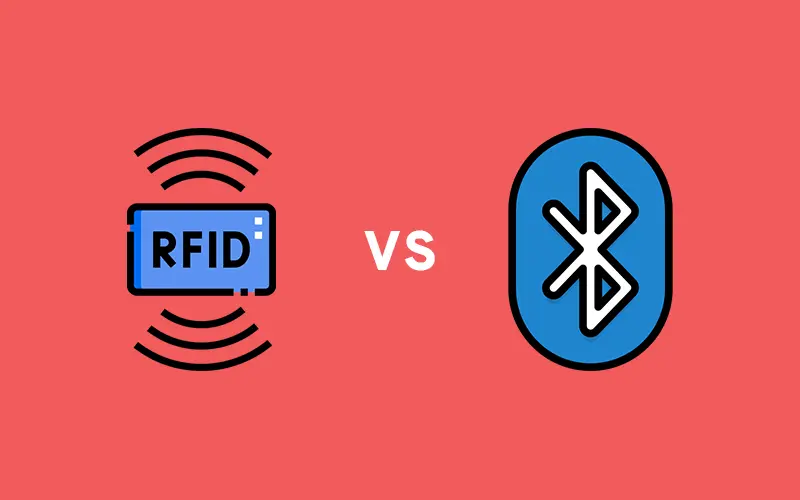In today’s global market, supply chain optimization is crucial for businesses striving to meet the demands of efficiency, cost reduction, and customer satisfaction. According to a study by the World Economic Forum, supply chain inefficiencies cost businesses up to $2 trillion annually. These inefficiencies underscore the pressing need for innovative solutions in asset tracking and supply chain management.
Among the leading technologies are RFID (Radio-Frequency Identification) and Bluetooth, each offering distinct advantages and challenges. This article delves into the comparative benefits of RFID and Bluetooth for asset tracking and supply chain optimization.
RFID Technology
RFID technology uses electromagnetic fields to automatically identify and track tags attached to objects. An RFID system comprises three main components: RFID tags, RFID readers, and a data processing system.
RFID tags contain a microchip and an antenna and come in two types: passive and active. Passive tags rely on electromagnetic energy from the RFID reader, while active tags have their power source, allowing for a longer read range and more data storage. RFID readers, which can be handheld or fixed, emit radio waves and receive signals from these tags. The data collected by RFID readers is processed by a data processing system, enabling real-time tracking and management of assets.
2026 RFID Integration Guide
A complete guide that will help retail brand owners, manufacturers, and distributors reap great benefits from integrating RFID into their supply chain.
Bluetooth Technology
Bluetooth technology is a wireless communication standard that enables the exchange of data over short distances. It is commonly used in personal devices like smartphones, headphones, and laptops but has also found applications in asset tracking.
Bluetooth tags, also known as beacons, are attached to assets and continuously broadcast a Bluetooth signal containing a unique identifier. Bluetooth readers, or gateways, receive these signals and can be integrated into smartphones, tablets, or dedicated Bluetooth receivers. The data from Bluetooth readers is then processed to provide real-time tracking and management of assets.
Comparing RFID and Bluetooth for Asset Tracking
RFID and Bluetooth offer distinct approaches to asset tracking, each with its own strengths and weaknesses.
| Aspect | RFID | Bluetooth |
|---|---|---|
| Range and Coverage | Passive RFID: Up to a few meters; Active RFID: Up to 100 meters. Suitable for applications like inventory tracking in warehouses and asset tracking in larger areas. | Standard Bluetooth: Up to 100 meters (range can be reduced by obstructions); Bluetooth Low Energy (BLE) extends range and reduces power consumption. Suitable for various environments. |
| Cost | Passive RFID tags: a few cents each; Active RFID tags: several dollars each. Additional costs for RFID readers and infrastructure. | More expensive than passive RFID tags but less costly than active ones. Potentially lower implementation costs due to the widespread use of Bluetooth in consumer devices. |
| Data Capacity and Processing | Varies from a simple identifier to complex information. Active tags can store and transmit more data. Enables real-time tracking and management of assets. | Primarily transmits a unique identifier. Additional data stored and processed by connected devices. Integration with smartphones allows for flexible and scalable data processing. |
| Power Consumption | Passive RFID: No internal power source (maintenance-free); Active RFID: Requires battery replacement periodically. | BLE significantly reduces power consumption. BLE tags can operate for months or years on a single battery, depending on usage. |
| Ease of Implementation and Scalability | Complex implementation with significant upfront investment. Highly scalable once established. | Easier implementation, especially where smartphones/tablets are used. BLE tags can be quickly deployed and integrated into existing systems. Scalable with additional gateways. |
Use Cases and Applications
These technologies offer strong applications in these industries and areas.
RFID in Supply Chain Optimization
- Inventory Management: RFID technology enables precise and real-time inventory tracking, reducing the likelihood of stockouts and overstock situations. Retailers can quickly locate items within a warehouse, improving order fulfillment times.
- Asset Tracking: In manufacturing, RFID tags attached to machinery and equipment allow for real-time monitoring of asset location and status. This reduces downtime and enhances maintenance scheduling.
- Logistics and Transportation: RFID is used to track shipments throughout the supply chain, providing visibility from the point of origin to the final destination. This reduces the risk of lost or misplaced goods and improves overall supply chain efficiency.
Bluetooth in Supply Chain Optimization
- Warehouse Management: Bluetooth beacons can be used to track the movement of goods within a warehouse, optimizing storage and retrieval processes. The integration with mobile devices allows for real-time updates and easy access to inventory information.
- Cold Chain Monitoring: Bluetooth can monitor temperature and humidity levels in real-time, ensuring that perishable goods are stored and transported under optimal conditions. This is crucial for industries like pharmaceuticals and food.
- Employee Tracking and Safety: In large facilities, Bluetooth beacons can track employee movement and ensure safety protocols are followed. This enhances productivity and ensures compliance with safety regulations.
Conclusion
Both RFID and Bluetooth offer significant advantages for asset tracking and supply chain optimization, but their suitability depends on specific use cases and requirements.
RFID excels in scenarios requiring long-range tracking and high data capacity, making it ideal for large-scale industrial applications. Bluetooth, particularly BLE, offers ease of implementation and integration with existing consumer devices, making it a flexible and cost-effective solution for smaller businesses and specialized applications.
By understanding the strengths and limitations of each technology, businesses can make informed decisions to enhance their supply chain operations and drive efficiency.
Interested in RFID?
An RFID tracking system can help organizations of all sizes improve their supply chain efficiency. Contact the CYBRA team to schedule a demo today.
















